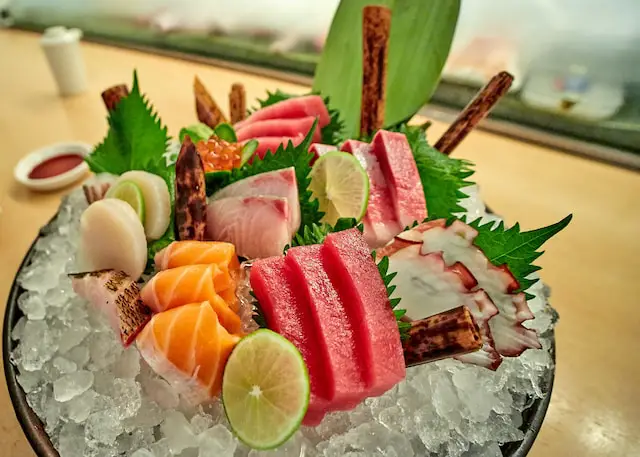Why Is Sashimi So Expensive?
Sashimi, a traditional Japanese delicacy consisting of thinly sliced raw fish or seafood, is renowned for its exquisite taste and premium quality. However, it is no secret that sashimi can come with a hefty price tag. Many factors contribute to the high cost of sashimi, making it a luxury indulgence for seafood enthusiasts and culinary connoisseurs. In this article, we will explore why sashimi is so expensive and delve into the various elements that drive up its price.
Quality and freshness
One of the primary reasons for the high cost of sashimi is the emphasis on quality and freshness. To ensure the best flavor and texture, sashimi-grade fish and seafood must be sourced from reputable suppliers and caught using sustainable fishing practices. This requires meticulous selection and handling processes to maintain the highest standards. The fresher the fish, the better the taste, and the higher the price.
Rarity and availability
Certain types of fish used for sashimi are rare and not easily accessible. Species like bluefin tuna, uni (sea urchin), and king crab are highly sought after but limited in supply. Their scarcity drives up the price, as demand outweighs availability. Additionally, seasonal variations and fluctuations in fish populations can further impact their availability and cost.
Handling and preparation
Preparing sashimi requires exceptional skill and precision. Expert chefs with extensive knowledge of fish anatomy and cutting techniques are essential to creating perfectly sliced, visually appealing pieces. The labor-intensive process of filleting, removing bones, and achieving the ideal thickness for each slice adds to the overall cost of sashimi.
Traceability and sustainability
Sustainable fishing practices and responsible sourcing are essential considerations in the seafood industry. Fisheries that prioritize conservation and ecological balance may have higher operational costs, which are reflected in the price of sashimi. The traceability of fish, ensuring they are caught legally and ethically, also contributes to the overall cost as it requires proper documentation and certification.
Food safety and hygiene
Maintaining food safety standards is paramount in the production of sashimi. From the moment the fish is caught to its transportation, storage, and handling, stringent protocols are followed to ensure freshness and prevent contamination. Regular testing, inspections, and adherence to health regulations increase the cost of production and, consequently, the price of sashimi.
Cultural Significance and Craftsmanship
Sashimi holds great cultural significance in Japanese cuisine and is considered a form of culinary art. The dedication and craftsmanship involved in creating exceptional sashimi dishes require years of training and experience. Chefs who possess the skills to masterfully prepare sashimi command higher wages, contributing to the overall cost of the dining experience.
Demand and exclusivity
Sashimi is often associated with high-end dining establishments and gourmet experiences. Its exclusivity and association with luxury contribute to its premium pricing. The demand for sashimi, both domestically and internationally, plays a significant role in setting its price. The reputation and popularity of certain fish species also influence their market value.
In conclusion, the elevated cost of sashimi can be attributed to various factors such as quality, rarity, handling, sustainability, food safety, cultural significance, and demand. These factors, combined with the skill and craftsmanship required to create exceptional sashimi, contribute to its luxurious appeal and make it a delicacy enjoyed by those willing to indulge in the finest seafood experiences.
Frequently Asked Questions
What is sashimi?
Sashimi is a Japanese culinary delicacy consisting of thinly sliced raw fish or seafood that is served without any cooking or heat treatment. It is typically made from high-quality, fresh fish that is carefully selected and expertly sliced by skilled chefs. The word “sashimi” itself means “pierced body” in Japanese, referring to the traditional method of slicing the fish into thin pieces.
Sashimi is known for its clean and delicate flavors, as well as its emphasis on showcasing the natural taste and texture of raw fish. The most common types of fish used for sashimi include tuna, salmon, yellowtail, mackerel, and snapper. However, other seafood like shrimp, octopus, scallops, and sea urchin (uni) can also be served as sashimi.
To enjoy sashimi, the slices of fish are often arranged artfully on a plate and accompanied by garnishes such as shredded daikon radish, soy sauce, wasabi, and pickled ginger. The condiments are meant to enhance the flavors of the fish without overpowering its delicate taste.
Sashimi is highly regarded in Japanese cuisine and is known for its freshness, quality, and visual presentation. It requires meticulous handling and precise knife skills to ensure the slices are cut with precision and uniformity. Sashimi is commonly served as an appetizer or as part of a traditional Japanese meal, alongside sushi, rice, and other side dishes.
What is sashimi sushi?
Sashimi and sushi are two distinct dishes in Japanese cuisine, but they are often served together and can complement each other in a meal.
Sashimi refers to thinly sliced raw fish or seafood that is served without any rice or additional ingredients. It highlights the natural flavors and textures of the fish, allowing you to fully appreciate the freshness and quality of the seafood. Sashimi is typically served with soy sauce, wasabi, and pickled ginger as condiments to enhance the flavors.
Sushi, on the other hand, consists of vinegared rice combined with various ingredients, including raw or cooked fish, vegetables, and sometimes even cooked egg or tofu. Sushi can be served in different forms, such as nigiri sushi (a small mound of rice topped with a slice of fish or another ingredient) or makizushi (rolled sushi with rice and fillings wrapped in seaweed).
When sashimi is combined with sushi, it is often referred to as “sashimi sushi” or “sashimi-style sushi.” In this case, thin slices of raw fish or seafood are placed on top of a small mound of sushi rice, creating a harmonious blend of flavors and textures. The rice acts as a neutral base to support the sashimi, adding a slightly sweet and tangy taste from the vinegar seasoning.
Sashimi sushi allows you to enjoy the best of both worlds—the clean and pure flavors of the sashimi combined with the subtle tang of the sushi rice. It is a popular choice for sushi enthusiasts who appreciate the delicate balance of textures and flavors in a single bite.
It’s worth noting that sashimi sushi should be consumed with caution, ensuring that the raw fish used is of high quality and sourced from reputable suppliers to minimize any health risks associated with consuming raw seafood.
How to make sashimi?
Making sashimi at home requires careful handling of fresh, high-quality fish or seafood. Here’s a general guide on how to make sashimi:
1. Choose the right fish: Select fresh, sushi-grade fish or seafood. Common options for sashimi include salmon, tuna, yellowtail, sea bream, scallops, and squid. Purchase from a trusted fishmonger or seafood market.
2. Prepare the fish: Start by ensuring the fish is properly cleaned and filleted. Remove any bones, scales, and skin. It’s important to work with sharp knives to make clean, precise cuts.
3. Chill the fish: Place the fish in the refrigerator for a few hours or in the freezer for a shorter time to firm up. This step helps in achieving clean slices.
4. Slice the fish: Use a very sharp knife to make thin, even slices. Cut against the grain to maintain the desired texture. The thickness of the slices depends on personal preference, but they are typically around 1/8 to 1/4 inch thick.
5. Arrange the sashimi: Arrange the sliced fish attractively on a clean plate or a bed of ice. You can garnish with shredded daikon radish, shiso leaves, or edible flowers for added visual appeal.
6. Serve with condiments: Provide traditional condiments alongside the sashimi, including soy sauce, wasabi (Japanese horseradish), and pickled ginger. These add flavor and balance to the sashimi.
7. Enjoy immediately: Sashimi is best enjoyed fresh, so serve it immediately after preparation. The delicate flavors and textures are at their prime when consumed right away.
It’s important to note that making sashimi requires precision, sharp knives, and proper handling of raw fish. If you’re new to preparing raw seafood, it’s recommended to seek guidance from a professional or experienced cook to ensure food safety and proper technique.
What is the difference between sushi and sashimi?
Sushi and sashimi are both popular dishes in Japanese cuisine, but they have distinct differences:
1. Ingredients: Sushi typically consists of vinegared rice combined with various ingredients like raw or cooked fish, seafood, vegetables, and sometimes even meat. On the other hand, sashimi refers specifically to thinly sliced raw fish or seafood, served without rice.
2. Rice Presence: Sushi always includes seasoned rice as a base, which is a combination of rice, vinegar, sugar, and salt. Sashimi, on the other hand, does not include any rice and focuses solely on showcasing the flavor and texture of the raw fish or seafood.
3. Presentation: Sushi is often presented as bite-sized rolls or nigiri (slices of fish or seafood placed on top of a small mound of rice). Sashimi is usually presented as thinly sliced pieces of fish or seafood arranged artfully on a plate.
4. Eating Style: Sushi is commonly eaten with chopsticks and sometimes dipped in soy sauce mixed with a small amount of wasabi (Japanese horseradish). Sashimi is typically eaten with chopsticks as well, but it is dipped directly into soy sauce or soy sauce with wasabi.
5. Variety: Sushi offers a wide variety of options, including both raw and cooked ingredients, vegetarian options, and creative combinations. Sashimi, on the other hand, focuses solely on raw fish or seafood and allows diners to experience the pure flavors of the ingredients.
In summary, sushi includes rice and a variety of ingredients, while sashimi consists of thinly sliced raw fish or seafood served without rice. Both dishes have their unique qualities and are enjoyed in different ways, depending on personal preferences.
How to cut sashimi?
Cutting sashimi requires precision and sharp knives. Here’s a general guide on how to cut sashimi:
1. Choose Fresh Fish: Start with high-quality, fresh fish or seafood. Common choices for sashimi include salmon, tuna, yellowtail, and snapper. Ensure that the fish has been properly cleaned and deboned.
2. Sharpen Your Knife: Use a long, sharp, and non-serrated knife specifically designed for slicing sashimi. Ensure the blade is clean and sharpened to make clean, smooth cuts.
3. Slice Against the Grain: Place the fish on a clean cutting board and hold it firmly. Slice the fish at a slight angle against the grain to create thin, even slices. The angle and thickness of the cuts can vary depending on personal preference and the type of fish.
4. Control Pressure: Apply gentle, controlled pressure while cutting. Let the sharpness of the knife do the work, and avoid sawing or applying excessive force that could damage the texture of the fish.
5. Uniformity and Presentation: Aim for uniform slices to ensure consistent texture and appearance. Try to make each slice of sashimi of equal thickness. Arrange the slices on a plate in an aesthetically pleasing manner.
6. Chill Properly: Once the sashimi slices are cut, keep them refrigerated until ready to serve. Serve the sashimi chilled to maintain freshness and enhance the flavor.
It’s important to note that cutting sashimi requires skill and practice. If you’re new to handling raw fish, it’s recommended to seek guidance from an experienced chef or attend a cooking class to learn proper techniques and ensure food safety.
How to eat sashimi?
To fully enjoy the flavors and textures of sashimi, follow these steps:
1. Choose Fresh Sashimi: Start with high-quality, fresh sashimi from a reputable source. Ensure that the sashimi has been properly handled, stored, and prepared.
2. Observe Presentation: Take a moment to appreciate the presentation of the sashimi. It is often served on a plate or platter with garnishes or decorative elements. The arrangement is designed to be visually appealing.
3. Use Chopsticks: Sashimi is traditionally eaten with chopsticks. If you’re unfamiliar with using chopsticks, practice beforehand to enhance your dining experience.
4. Optional Dipping Sauces: Sashimi is typically enjoyed without heavy sauces to allow the natural flavors of the fish to shine. However, small dishes of soy sauce, wasabi, and pickled ginger are usually served alongside for you to add according to your preference. Use them sparingly to enhance the flavors.
5. Dip and Enjoy: If you choose to use soy sauce, pour a small amount into the small dish provided. Use your chopsticks to pick up a piece of sashimi and lightly dip it into the soy sauce. Be mindful not to soak the sashimi excessively, as it may overpower the delicate flavors.
6. One Bite Delicacy: Place the dipped sashimi into your mouth in one bite. This allows you to experience the full combination of flavors and textures. Chew slowly and savor the taste.
7. Palette Cleansing: Between different types of sashimi or bites, it is common to cleanse your palette. Eat a small piece of pickled ginger to refresh your taste buds before moving on to the next piece of sashimi.
8. Enjoy Variety: Explore different types of sashimi, as each fish has its unique taste and texture. Experiment with the available options and find your favorites.
9. Respect Tradition: Embrace the cultural significance of sashimi by eating it with respect and appreciation. Engage in conversation about the flavors, textures, and origins of the sashimi if dining with others who share your interest.
Remember, sashimi is a raw delicacy, so it’s important to ensure that the sashimi is fresh and prepared using proper food safety practices. Enjoy sashimi in moderation and savor the experience of each piece.
Where to buy sashimi-grade fish?
To ensure you purchase sashimi-grade fish, it’s best to buy from reputable sources that specialize in providing high-quality seafood. Here are some options to consider:
1. Local Fish Markets: Look for reputable fish markets in your area that have a reputation for selling fresh seafood. These markets often source their fish from trusted suppliers and may have a section dedicated to sashimi-grade fish. Ask the fishmonger about the freshness and quality of the fish before making a purchase.
2. Japanese or Asian Grocery Stores: Japanese or Asian grocery stores are commonly known for offering a wide selection of seafood, including sashimi-grade fish. These stores often cater to a clientele interested in traditional Japanese cuisine and may have a dedicated section for sashimi ingredients. Check the labeling or ask the store staff to ensure the fish is suitable for raw consumption.
3. Online Seafood Retailers: Many online seafood retailers specialize in delivering high-quality fish and seafood directly to your doorstep. Look for reputable online suppliers that specifically mention sashimi-grade fish. Read reviews and check their sourcing and handling practices to ensure you’re getting fresh and safe fish.
4. Local Restaurants or Sushi Chefs: Some restaurants or sushi chefs may sell sashimi-grade fish directly to customers. If you have a favorite sushi restaurant or know a skilled sushi chef, inquire if they offer sashimi-grade fish for sale. They may have access to premium seafood and can guide you in selecting the right fish for sashimi.
When purchasing sashimi-grade fish, remember the importance of freshness, proper handling, and safe storage. It’s crucial to trust the source and ensure that the fish has been handled with care to minimize the risk of foodborne illnesses. If in doubt, consult with the experts at the fish market or seek recommendations from experienced sushi chefs or seafood enthusiasts.
What is sashimi vs nigiri?
Sashimi and nigiri are both popular forms of Japanese cuisine, but they differ in terms of presentation and preparation:
1. Sashimi: Sashimi refers to thin slices of raw fish or seafood that are served without any rice. It showcases the freshness, texture, and flavor of the fish. The fish is typically sliced into bite-sized pieces and served with soy sauce, wasabi, and pickled ginger on the side. Sashimi can include various types of fish, such as salmon, tuna, yellowtail, or scallops, as well as other seafood like octopus or shrimp.
2. Nigiri: Nigiri is a type of sushi that consists of a slice of raw or cooked fish or seafood placed on top of a small mound of vinegared sushi rice. The rice is hand-formed into a compact shape, often with a bit of wasabi between the fish and rice to enhance the flavors. Nigiri allows for a harmonious combination of fish and rice, with the rice providing a slightly tangy and slightly sweet contrast to the fish’s flavor.
While both sashimi and nigiri showcase raw fish or seafood, the key distinction is that sashimi is served without rice, while nigiri combines the fish with a small portion of sushi rice. The choice between sashimi and nigiri often depends on personal preference and the dining experience one seeks. Sashimi allows for a pure and direct taste of the fish, while nigiri offers a balanced combination of flavors and textures from the fish and rice.













